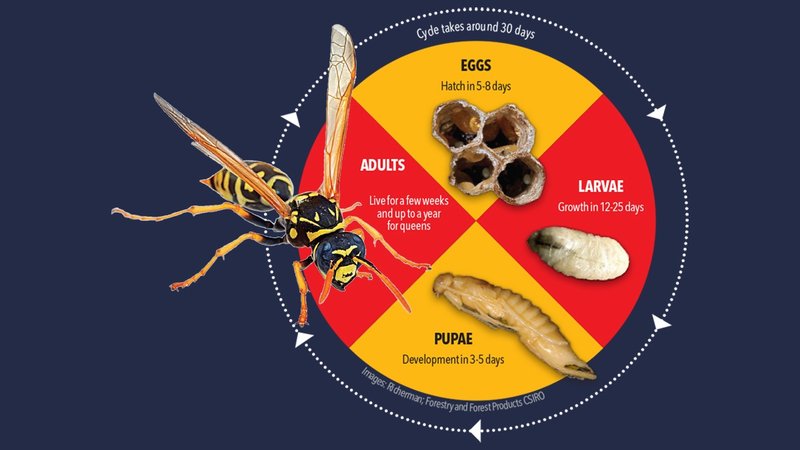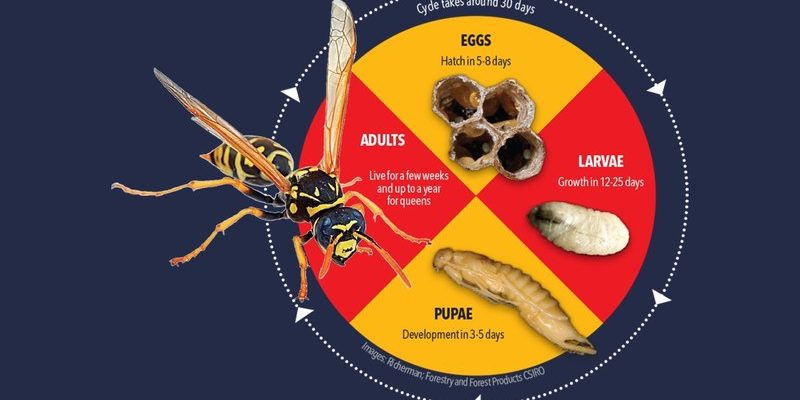
Let’s dive deep into the lifecycle of a wasp and explore what happens from the moment the egg is laid all the way to adulthood. Think of it like following a mini-drama where each character has its crucial role. Whether it’s the queen laying eggs or the workers building nests, everything contributes to the wasp community, and it’s a journey worth understanding.
What Are the Stages of a Wasp’s Lifecycle?
The lifecycle of a wasp typically consists of four distinct stages: egg, larva, pupa, and adult. This process is known as complete metamorphosis, which means the wasp undergoes drastic changes as it grows. Let’s take a closer look at each stage.
1. Egg Stage
The journey begins when a queen wasp lays her eggs in a specially prepared nest. These nests can be found in trees, shrubs, or even in the ground. The queen uses a sticky substance to attach the eggs to the nest, and she can lay anywhere from a dozen to several hundred eggs at a time.
After about three to five days, the eggs hatch into small larvae. During this time, the eggs are vulnerable to predators, and the queen carefully guards them. This stage is crucial, as it sets the foundation for the entire colony.
2. Larva Stage
Once the eggs hatch, the larvae emerge. These little “caterpillar-like” creatures are white, blind, and completely helpless. They rely entirely on their adult caregivers—usually the worker wasps. Here’s the thing: the workers feed the larvae a diet of nectar, plant matter, and even other insects.
The larvae grow quickly, shedding their skin multiple times. This growth period lasts about two to three weeks. It’s a bit like a teenager going through a growth spurt. They’re lounging around, eating, and preparing for the big transformation ahead!
3. Pupa Stage
After the larval stage, the wasp enters the pupa phase. During this time, the larva spins a silk cocoon and wraps itself within it. This is where the magic happens! Inside the cocoon, the larva undergoes incredible changes, reshaping its body into that of an adult wasp. It’s kind of like a superhero transforming into their suit.
The pupal stage can last anywhere from a week to a month, depending on the species and environmental conditions. Eventually, the adult wasp emerges, ready to take on the world.
4. Adult Stage
Now we reach the final stage: adulthood! Adult wasps are fully formed and, depending on the species, can be either male or female. Their primary tasks include gathering food, defending the nest, and, if they’re females, laying eggs. Adult wasps continue the cycle, ensuring that new generations will follow.
Interestingly, in many species, only the fertilized female wasps survive the winter. They hibernate in sheltered spots, ready to start the whole cycle again in the spring. It’s a bittersweet reality for the worker wasps, which typically live only for about 20 days.
How Does the Lifecycle of a Wasp Benefit the Ecosystem?
You might be wondering why we should care about wasps and their lifecycle. After all, many people find them annoying. But these creatures play crucial roles in our ecosystem.
- Pollination: Wasps help pollinate plants, contributing to the growth of fruits and flowers.
- Pest Control: They feed on other insects, helping control pest populations that could harm crops.
- Decomposers: Wasps contribute to breaking down organic matter, aiding in nutrient cycling.
In short, wasps are nature’s unsung heroes. Understanding their lifecycle can help us appreciate their role in maintaining balance in our environment.
Challenges and Threats to Wasp Populations
Like many insects, wasps face several challenges today. Habitat destruction, climate change, and pesticide use are significant threats that impact their lifecycle and populations.
For example, the loss of natural habitats means fewer places for queens to build nests. Moreover, pesticides can kill wasps directly or disrupt their food sources. This decline can ripple through ecosystems, affecting other species and even us.
It’s essential to advocate for environments that support these creatures, as they, in turn, support us. Simple steps like planting native flowers, reducing pesticide usage, and educating others can help.
What to Do If You Encounter Wasps
If you happen upon a wasp nest or find yourself in close proximity to these buzzing insects, it’s important to stay calm. Here are some tips to deal with wasps effectively:
- Avoid Swatting: Quick movements may provoke them. Stay still until they disperse.
- Don’t Aggravate: If a wasp is nearby, remain calm. They usually are not aggressive unless threatened.
- Seek Help: If you have a nest on your property, consider contacting a pest control professional rather than trying to remove it yourself.
Awareness and understanding can help us coexist with wasps rather than living in fear of them.
The lifecycle of a wasp—from egg to adult—is a captivating journey that highlights the complexity of nature. Each stage, from the vulnerable egg to the fully formed adult, plays a vital role in maintaining our ecosystem. While they may seem pesky at times, wasps contribute significantly to pollination, pest control, and nutrient cycling.
By respecting their place in our environment and understanding their lifecycle, we can better appreciate these remarkable creatures. So, the next time you see a wasp buzzing about, take a moment to consider the incredible journey that brought it here. After all, every creature has a story worth telling.

